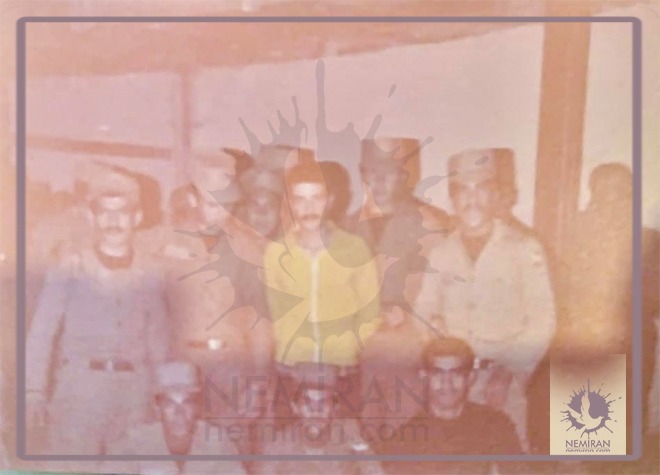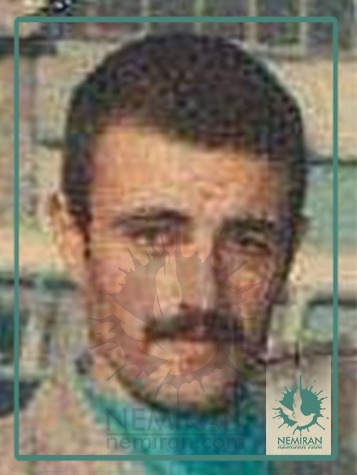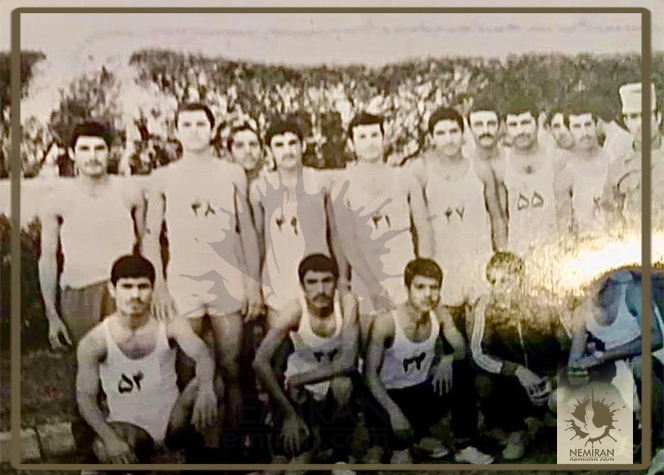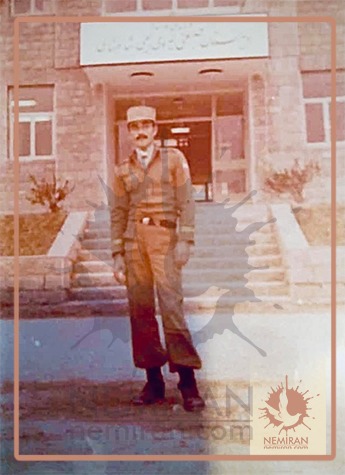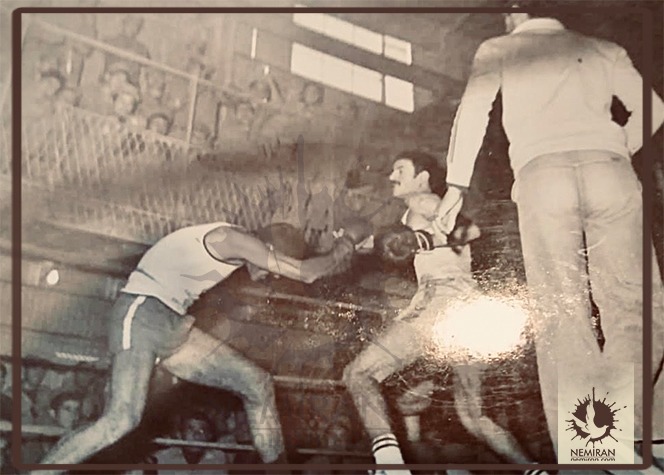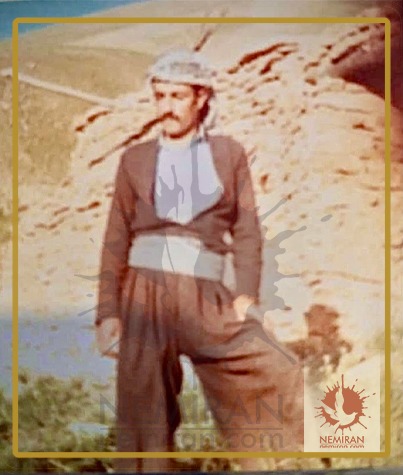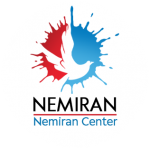It was 5/6/1358 Iranian Calendar (27/8/1979) in Sanandaj Airport. Eleven men stand with their hands clasped in front of Mullah Khalkhali and judges of the military special court of the Islamic Republic. Ten men were sitting on a bench and one wounded man is lying on a stretcher near the door.
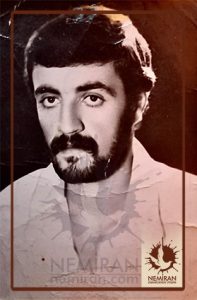
According to Khalil Bahrami, Khalkhali took off his turban; he put his shoes on the chair. He stared at the men from behind the glasses and asked their names. The men introduced themselves one by one:
1- Ahsan Nahid 2- Shahriar Nahid 3- Jamil Yakhchali 4- Nasser Salimi 5- Abdullah Fouladi 6- Muzaffar Niazmand 7- Sirus Manouchehri 8- Asghar Mobaseri 9-Mozaffar Rahimi10- Ata Zandi 11-Isa Pirwali
Khalkhali read the names one by one and proclaimed the charges. He charged them with smuggling of weapons, stirring up a riot and murder. He provided no evidence for all these charges. Khalkhali called eleven men corruptors on earth (an Islamic charge which is sentenced to death) and sentenced them to death. The entire court session lasted less than 30 minutes. Some of these eleven men shouted that they were innocent. Some others did not say anything and were shocked by their death sentence. The men were then taken to the outside of the airport area less than 100 meters far from the pseudo courtroom. Their eyes were blindfolded. Ahsan Nahid (the wounded man) was placed on the ground lying on the stretcher. The roar of helicopter wings rose. Moments later, ten men fell to the ground. A man in white wore sunglasses and had a pistol in his hand. He bent over the heads of the eleven one by one and fired coup de grace at their heads.
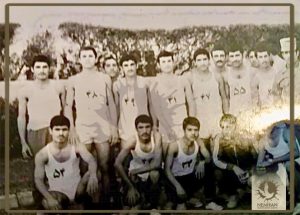
In the photos taken by Jahangir Razmi from the moment of execution at Sanandaj airport, the men are in different positions. In the most famous of these images, known asFire Squadron, which won the 1980 Pulitzer Prize, Nasser Salimi is the first one to stand on the right side with a wounded hand. The second person who is leaning forward is Jamil Yakhchali, a 20-year-old young man from Sanandaj. Forty-two years after this picture had been taken, Najmeh Yakhchali, Jamil’s older brother, tells the story of the life and execution of his brother, Jamil Yakhchali, in a conversation at the Nemiran Foundation clubhouse:
Jamil Yakhchali was from a large family. His mother Hamideh Saed and father Saleh Yakhchali had 13 children, four of the 13 died in infancy. Jamil was the seventh child of the remaining nine children, born in the year 1338 (1959). In contrast to his brothers who were always mischievous, Jamil was a very calm, humble and reticent boy. He was a student until the ninth grade in Sanandaj. He participated in the Industrial High School exam in the city of Masjed Soleiman, was accepted, and continued his education there.
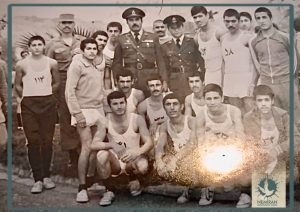
At that time, Najmeh, his elder brother, was political activist and supporter of the Fadaiyan e Khalq Organization (a left oriented organization). He kept books, magazines and night newspapers at home. Access to these books and publications and reading them motivated Jamil to political activity. Evidence shows that he became interested in politics at the age of 16. Najmeh recalls that after the revolution, Jamil, who had returned from Masjed Soleyman, held an exhibition of photographs, books and cassette tapes with his friends and invited him to visit them there.
It is not clear how and when Jamil was exactly arrested. A few days before the execution at Sanandaj airport, Jamil, along with Ahsan and Shahriyar Nahid, and several others went to Saqqez to do a task for his organization. The feudal lords and the landlords intended to prevent the division of the lands that the Komala party had already started in parts of Kurdistan by force of arms. A conflict happened between the feudal lords and the Komala party, which is also known as the Khorkhore war. Fadaiyan e Khalq Organization sent several people to Kurdistan to support the Komala Party. On the way back from Marivan to Qatvand checkpoint (gendarmerie checkpoint between Sanandaj and Marivan Garan road), their car was searched through by the Revolutionary Guards. They found a number of weapons along with documents of Fadaiyan e Khalq Organization which were embedded in the car. The group was arrested. The full description of the event is from the book “To be recorded in history” by Jamil Noura, which is narrated by Ahsan Nahid:

„While the Revolutionary Guards were searching through our car, they found a number of weapons along with documents that were embedded in the car of the Fadaiyan e Khalq Organization. They arrested us and labeled us counter-revolutionaries. A person from Kermanshah fled in the first minutes and saved himself from death. After his escape, the Guards got attentive and very careful. We were transferred to a room which didn’t look like a prison. It looked like we would be there temporarily. Another detainee who was there for a short time was called out. Most of those armed there were local mercenaries. In these circumstances we were exposed to great danger. They had found our documents and weapons and could use them as evidence. We had to do something because they would soon hand us over to the Sanandaj Revolutionary Guards. The three of us exchanged looks and decided to escape and we carried it out quickly during our transfer. The checkpoint lay on a hill. A canal had been dug in the ground due to the flow of water and was located nearby. We passed the checkpoint to this canal fast and got there. The guards fired at us but did not hit us. We had already identified the route. We zigzagged and ran this path separated from each other. We were warned several times to stop, we had made our decision. An arrow hit my thigh where the canal was divided into two parts. I could no longer continue to run. I took a few steps after my comrades. They had not yet noticed that I was injured. The pursuers were far away from us and had taken us under the fire of their guns. Jamil and Shahriar realized that I was not behind them. They came back and reached me. They were trying to take me with them.
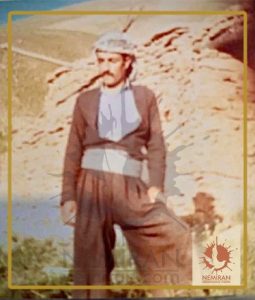
The bullet had hit my thighbone. I could not stand on my hit leg. Jamil and Shahriyar put my arms around their neck and tried very hard to save me too. They changed path through the canal. This route had many ups and downs and made them tired. Regime’s mercenaries had set fire mainly to this route. As we moved away, we came to an area covered with trees. There was a flat piece of land between the trees. Stacks of harvested clover were placed there to dry. We saw someone working on the field. We asked him to shelter me. He was horrified to hear the shooting and hesitant to help us. The armed forces were getting closer. I repeatedly asked Jamil and my brother Shahriar to leave me back and flee. They did not accept my plea. They decided to hide me under the piles of clover, because they were exhausted and couldn’t carry me anymore. The mercenaries were very close. The owner of the garden was also terrified. After hiding me under the clover and the grass, which had not dried completely, my comrades hid themselves in the trees nearby, watching what would happen to me. The armed men arrived. One of them called the landowner from a distance and ordered him to show up. The owner of the garden obviously had hidden himself out of fear. He came out of his hiding place. My comrades saw it all, but they couldn’t hear what the men said. After talking to the owner of the garden, the guards searched every corner. They asked us to surrender. They had no fear, because they were sure we didn’t have guns. I did not move. The heat under the clover bothered me and was extremely exhausting. My thigh pain made it ten times worse. They were flipping the cloverpiles over until they reached the pile above me. They pushed it aside and pulled me out. Shahriyar and Jamil saw that I was captured, came out of the hiding place and surrendered. They could have escaped and saved themselves from this predicament, but they did not. It was clear that they did not want to leave me alone. They handcuffed Shahriyar and Jamil and brought us back to the checkpoint. We were immediately transferred to Sanandaj. I was brought to Sanandaj barracks for “medical treatment.”
Jamil’s family visited him several times in the gendarmerie detention center. His family tried to get him free, but all attempts failed.
A few days later, they were transferred to Sanandaj airport, where Jamil and Shahriyar saw Ahsan again (he had been already transferred there for “medical treatment”). The next day, a Mullah named Hashtroudi came and took them for interrogation several times. In the evening of the same day, they were taken to another airport building where the other prisoners were also held. The Nahid brothers (Ahsan and Shahriyar) and Jamil were interrogated once again. A guard came the next day between 2 and 3 o’clock in the afternoon and called the names of these prisoners:
1 – Ahsan Nahim
2 – Shahriyar Nahid
3 – Jamil Yakhchali
4 – Muzaffar Niazmand
5 – Ata Zandi
6 – Asghar Mobaseri
7 – Nasser Salimi
8 – Isa Pirwali
The guards insisted that the called persons should wear their own shoes. In response to Jamil Noureh’s question, where the prisoners would be taken, the guards answered: “to Kermanshah”. Half an hour later, the unbearable noise of helicopter propellers was heard. From the dust that can be seen around the helicopters in the photos of the execution of 11 people, it is clearly to see that the helicopter propellers were turned on so that the sound of the firing squad could not be heard by the people who had gathered outside of the airport.

The family of Jamil Yakhchali heard from the execution of their son through Sanandaj regional television, which announced the news of mass execution on the airport site. After a lot of efforts the Yakhchali family succeeded in taking back their son’s corpse from the Revolutionary Guards. His body was buried on Sheikhan Cemetery. This poem is engraved on his tombstone:
My youth was like a flower
that grew up in the garden of life
it withered like an unfortunate anemones in spring
It put sorrow in our hearts and left.
After this mass execution, the people of Sanandaj staged demonstrations and protests, which were repressed brutally by the forces of the Islamic Republic. Sanandaj was imposed under very strict safety regulations. The atmosphere was like martial law.
The tragedy of the Yakhchali family did not end there. All family members were imprisoned. Jamil’s nephew, Hamid, was also killed in the 24-day war in Sanandaj. The graves of the two family members are located next to each other on Sheikhan Cemetery.
May their memory be cherished

